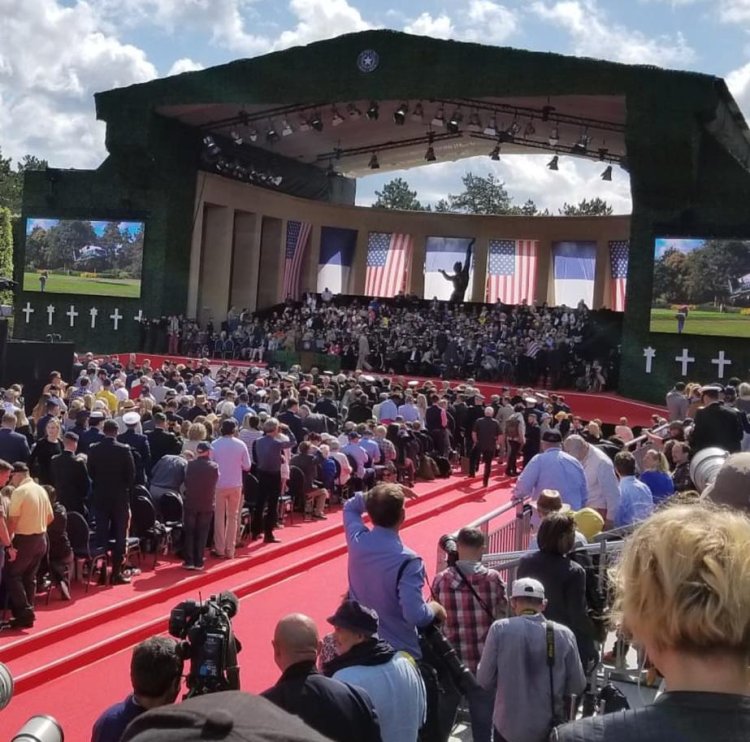D-Day Reflections from Normandy

In 2019, Marshall Swanson-Polston, Editor of Orlando Local News, traveled to Normandy to attend cerermonies commemorating the 75th anniversary of D-Day at the invitation of the President of the United States. The remembrance ceremony featured an allied memorial service as well as speeches from former Pres. Donald J. Trump, French leader Emmanuel Macron and other dignitaries.
Remembrances in honor of the "Longest Day" - as it is known by many - come once a year on June 6th. That fateful day in 1944 witnessed the deaths of nearly 20,000 American soldiers on the beaches of Normandy during Operation Overlord.
In 2019, the allies remembered the 75th anniversary of the operation. On most days, the bucolic countryside of Normandy beckons only a handful of tourists and a few buses. On June 6th, however, traffic increases to a fever pitch, and the 2019 commemoration brought even more crowds in a pilgrimage to honor the fallen.
The beauty of the foliage and beaches along the coastline disguise a landscape marred by war, century after century. But perhaps, among all those past empires and armies to trek across this strategically vital coast of France, it was the Americans who left the most indelible mark.
A hulking monument guards rows and rows of perfectly aligned white marble crosses at the Normandy American Cemetery. The grounds serve as the final resting place for thousands of American soldiers who gave the ultimate sacrafice, and chimes ring out every hour, playing American military favorites, patriotic marches and the National Anthem thorughout the day.
The cemetery, situated high on a cliff top, looks out on the waters of the English channel.
For much of the summer, a walk down to the beach brings to life just the kind of weather the troops experienced during the invasion, like a scene out of Saving Private Ryan, except far more real.
During the 75th anniversary commemoration, military vehicles furnished by collectors lined backlogs of congested roads up and down the coast. Although few veterans remain from the invasion, those still among us often attend the ceremonies of June 6th, with many volunteering their time to speak with young people and other visitors.
All along the coast, from Normandy American Cemetery to the famed cliffs of Pointe Du Hoc, the marks of war remain ever visible to those with a keen eye. At Pointe Du Hoc, massive craters dot the land atop the cliffs, with many just adjacent to still intact Nazi bunkers. The cliff was known as one of the most fortified Nazi positions.

Photo: Pre-invasion bombing of Pointe Du Hoc. Photo Credit: US Department of Defense.
Ronald Reagan spoke at the site in 1984 to honor the "Boys of Pointe Du Hoc" for their bravery. Years earlier, a monument was gifted by the French in gratitude for their sacrafice. The World War II Pointe du Hoc Ranger Monument is located on a cliff eight miles west of Normandy American Cemetery, which overlooks Omaha Beach, France. It was erected by the French to honor elements of the American Second Ranger Battalion under the command of Lt. Col. James E. Rudder.
During the American assault of Omaha and Utah beaches on June 6, 1944, these U.S. Army Rangers scaled the 100-foot cliffs and seized the German artillery pieces that could have fired on the American landing troops at Omaha and Utah beaches. At a high cost of life, they successfully defended against determined German counterattacks.
Visitors are encouraged to leave a wreath or flowers at any number of monuments on D-Day and year round.
For a visit to the coast of Normandy from England, the best means of transportation remains the ferry, although private bus, rental car and limited rail options exist from Paris as well. Although one might be able to spend days in Normandy, a one day visit is best topped off with lunch at any of the small towns along the coastline where both fine French cuisine and home cooked meals abound.
For more information about a visit to Normandy American Cemetery and Pointe Du Hoc, click here.
Gallery










 Marshall S. Swanson
Marshall S. Swanson 
















